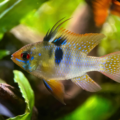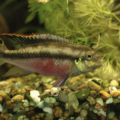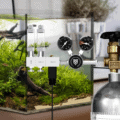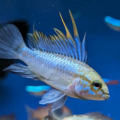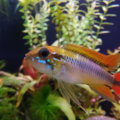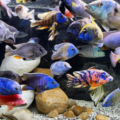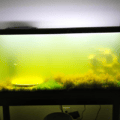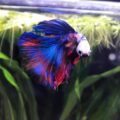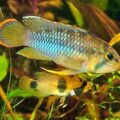All the reasons why you should use the Cockatoo Cichlid as the centerpiece in your community aquarium. Including breeding tips, tank setup. and health care tips.

Do you need a freshwater centerpiece fish to beautify your aquarium? Then, you’ll need a species with adaptable traits, stunning colors, and a showstopping presence in its habitat.
I know just the fish that’ll be a vibrant and hardy addition to your freshwater aquarium—Apistogramma cacatuoides, also known as the Cockatoo Dwarf Cichlid, is native to the Amazon River Basin in South America.
Now, you’re wondering how to bring this small yet stunning pet into an aquarium without hurting it. This Cockatoo Dwarf Cichlid overview will guide you through the best care tips.
Let’s start with an Apistogramma cacatuoides introduction.
A Splash of Colors: What Makes Apistogramma Cacatuoides Unique?
Identifying vibrant dwarf cichlids is easy, thanks to their striking sex dimorphism. Though they’re both small fish, the males are larger and more colorful than the females.
Let’s dissect the eye-catching appearance of this cichlid for a better understanding of their anatomy and needs.
Color Patterns


Cockatoos are colorful aquarium cichlids with vivid red, orange, and blue accented fins on a chrome silver body. Their gradient hues and fin patterns highlight any planted aquarium and give onlookers a showstopping experience!
However, these features vary depending on the individual’s health and genetics. You’ll soon see how this happens.
Unique Traits
Let’s discuss more Cockatoo Cichlid traits that earned this species its unique nickname, like its ridged and sharp fins, which look like a cockatoo bird’s crown.
It also has a peaceful yet territorial breeding personality and thrives in tanks with dense greenery like its natural habitat. Here’s how you can recreate this environment for your pets.
Designing the Perfect Home for Your Cockatoo Cichlid
Creating a suitable environment for Apistogramma cacatuoides is about replicating the natural habitat for Cockatoo Cichlids with appropriate tank decor and water conditions.
Tank Size and Layout
Building an ideal tank for dwarf cichlids starts with getting the right dimensions and layout. Because these pets are small, between 2 and 3 inches long, a 20-gallon tank per pair is the standard. It should also preferably be rectangular, not tall.
Next up is filling the tank with water.
Water Conditions
Cichlids thrive in soft, slightly acidic water with stable temperatures. So, set the following parameters for optimal existence:
| Temperature | 75 – 82℉ |
| pH | 6 – 7 |
| Hardness | 3 – 12dGH |
| Lighting | Moderate to Dim |
Use a low-current filtration system like a sponge or a gentle canister to keep the water clean.
Substrate and Decor
You can use substrate and decor to create a hyper-realistic pet tank.
Some aquarium decor ideas for Apistogramma cacatuoides include:
- Caves: Use shells from coconuts or snails to give your pets hiding spots and privacy during breeding.
- Substrate: Keep it soft and sandy to protect their barbels when foraging.
- Leaf Litter and Plants: Mixing Amazon Swords, Java fern, and Anubias with dried Indian Almond leaves creates dense vegetation for your pets.
- Driftwood: It also encourages tannin release and blends in with the environment.
These decorations give the tank a natural look and encourage normal behaviors like hiding and foraging.
Feeding Cockatoo Cichlids: A Recipe for Vibrant Colors
Apistogramma cacatuoides need a protein-rich cichlid diet to live a healthy life. But you must also supplement their meals with other plant-based foods because they’re omnivorous.
Nutrition for Cockatoo Cichlids needs to aid color enhancement while promoting good health. So, check out these options:
Diet Suggestions
Give them live food like mosquito larvae, blackworm, and daphnia as supplements, while pellets and flakes specially made for cichlids are good staples. If you can’t access live food, frozen foods like mysis and brine shrimp are ideal alternatives.
For more on feeding your aquatic pets check out The Ultimate Guide to Fish Food: Pros and Cons & Best Choices!
Feeding Tips
Ensure you always give your pets a balanced diet to fulfill all their dietary needs. For more Apistogramma cacatuoides feeding tips, I recommend creating a routine and portion control.
Feed them small food portions consumable in 3 minutes twice daily. It’ll reduce waste build-up and overfeeding.
Raising the Next Generation of Apistogramma cacatuoides

Breeding vibrant dwarf cichlids is an unforgettable experience because of their unique traits. You’d enjoy watching their fascinating courtship displays and maternal care but don’t get lost in the display.
Follow these Cockatoo Cichlid spawning tips for incredible results!
Breeding Setup
With slight modifications, you can use the same specifications as the living tank for the breeding ground. Include adequate breeding caves, maintain soft water, and stabilize the temperature at 78 – 82℉.
Courtship and Spawning
The males perform their courtship dance by spreading their colorful fins to attract the females who move to the breeding site their partners have marked. A ready female cockatoo cichlid shows physical signs with intense yellow and black markings on her fins and belly.
She’ll then lay 50-150 eggs on the flat surface you’ve provided, and the male will fertilize them externally. Both cichlids will protect and fan their eggs for oxygen until they hatch within 2-3 days.
Fry Care Tips
Upon hatching, the fry will stay in the cave and feed on their yolk sac until they develop into free-swimming fry in 4-7 days. Afterward, feed them infusoria and crushed flakes for fry until they grow large enough to eat normal-sized pellets and flakes.
I hope this Apistogramma fry care guide has been useful. It’s time to build a harmonious tank community for your pets.
Building a Harmonious Community with Cockatoo Cichlids

The best tank mates for Apistogramma cacatuoides are species that can coexist because of similar temperament, environmental needs, and physical traits. That way, you can create a peaceful and thriving community without competition for resources or stress.
Follow these tips for peaceful community tank setups.
Compatible fish for cockatoo cichlids include Neon Tetras, pencil fish, and otocinclus, while aggressive and hyperactive tank mates are avoided.
Keeping Your Cockatoo Cichlid Happy and Healthy
Without proper Cockatoo cichlid health maintenance, your pets will experience common health issues like parasitic infections, stress, or malnutrition. The good news is that this guide already prepares you with tips for preventing dwarf cichlid illnesses, which we’ll briefly recap before diving into signs of illnesses.
Preventative Measures
Routine water changes ensure the conditions stay pristine while temperature stability makes for optimal environments. Also, you can’t ignore proper diet because that’s the foundation of their health care. It’ll affect their moods, physical appearance, and internal organs.
Signs of Illness
That’s why faded colorations and loss of appetite are the earliest signs of illnesses. See the table below for more information:
| Signs | Illness | Causes | Treatment |
| Lethargy, Appetite Loss, Gasping | Dropsy | Internal bacteria, Poor water conditions and Stress | Antibacterial medication, improve water quality, separate fish from avoided species. |
| Discoloration, White Spots, | Ich | Parasitic infection | Increase water temperature to kill parasite |
| Rapid Gill Movement | Velvet | Ammonia Poisoning | Improve Water Quality and use copper-based medication |
Check out How to Treat Ich Outbreaks in Your Freshwater Fish for more information on Ich!
You’ll notice that illness prevention starts with following essential freshwater fish care tips, so don’t joke with this guide.
How to Ensure a Long, Vibrant Life for Apistogramma Cacatuoides
There are no magic Cockatoo Cichlid lifespan tips beyond this guide’s instructions.
Lifespan Factors
Diet, water quality, and stress-free tank conditions should be your focus if you want to invest in long-term care for dwarf cichlids. Once you perfect those three factors, your pets will live a healthy and long life.
Care Tips for Longevity
Maintaining vibrant freshwater fish starts with regularly observing patterns and investing in preventative measures. That way, you can quickly spot any abnormality and address it before it becomes a problem.
Conclusion
You now have a complete Cockatoo Cichlid care guide that’ll help you build an aquarium that’ll be the envy of every hobbyist.
It contains detailed care essentials for Apistogramma cacatuoides, including its appearance and engaging behaviors, which make it a beginner-friendly fish. So, it doesn’t matter if you’re inexperienced in fishkeeping.
Remember that to get the best out of this vibrant aquarium centerpiece fish, you must replicate its natural habitat from its environmental look to the tank mates, water conditions, and diet.
Once you start your aquarium, you can reference these Apistogramma cacatuoides care tips for refreshers and help. Have fun!


